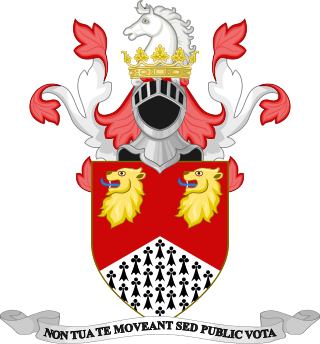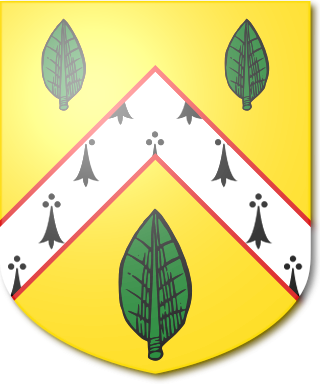
Charles Edward was the last sovereign duke of Saxe-Coburg and Gotha, from 30 July 1900 until 1918. A male-line grandson of Queen Victoria and Prince Albert, he was also until 1919 a Prince of the United Kingdom and from birth held the British titles of Duke of Albany, Earl of Clarence and Baron Arklow.
The Mellor Baronetcy, of Culmhead in the County of Somerset, was a title in the Baronetage of the United Kingdom. It was created on 24 January 1924 for Sir John Mellor, Director of Prudential Assurance Company. The second Baronet was the Conservative member of parliament for Tamworth from 1935 to 1945 and for Sutton Coldfield from 1945 to 1955. The baronetcy became extinct on the death of the third Baronet in 1990.

The Austin Baronetcy, of Red Hill in the parish of Castleford in the West Riding of the County of York, is a title in the Baronetage of the United Kingdom. It was created on 16 July 1894 for John Austin, Liberal member of parliament for Osgoldcross.
There have been two baronetcies created for persons with the surname Aykroyd, both in the Baronetage of the United Kingdom for members of the same family.
There have been two baronetcies created for persons with the surname Bingham, one in the Baronetage of Nova Scotia and one in the Baronetage of the United Kingdom.

The Alleyne Baronetcy, of Four Hills in Barbados, is a title in the Baronetage of Great Britain. It was created on 6 April 1769 for John Alleyne, Speaker of the Barbados House of Assembly. His grandson, the third Baronet, was President of the Steel and Iron Institute.

There have been two baronetcies created for persons with the surname Backhouse, once in the Baronetage of England and once in the Baronetage of the United Kingdom. As of 2023 one creation is extant.

The Bagge Baronetcy, of Stradsett Hall in the County of Norfolk, is a title in the Baronetage of the United Kingdom. It was created on 13 April 1867 for William Bagge, Conservative Member of Parliament for West Norfolk. The sixth Baronet was Chairman of the West Norfolk District Council between 1976 and 1977.

There have been two baronetcies created for the Guise family, one in the Baronetage of England and one in the Baronetage of Great Britain. The latter creation is extant as of 2014.
There have been two baronetcies created for persons with the surname Waring, both in the Baronetage of the United Kingdom. One creation is extinct while one is still extant.

The Briscoe Baronetcy, of Bourn Hall, in the Parish of Bourn, in the County of Cambridge, is a title in the Baronetage of the United Kingdom. It was created on 12 July 1910 for John James Briscoe. He was a County Alderman, a Justice of the Peace and Deputy Lieutenant for Cambridgeshire. His eldest son, the second Baronet, died childless and was succeeded by his younger brother, the third Baronet. As of 2023 the title is held by the latter's great-grandson, the sixth Baronet, who succeeded from birth in 1994, his father having died earlier that year.

The Blaker Baronetcy, of Brighton in the County of Sussex, is a title in the Baronetage of the United Kingdom. It was created on 5 September 1919 for Sir John Blaker. He was Mayor of Brighton from 1895 to 1898. He was succeeded by his son, the second Baronet. He sat as Conservative Member of Parliament for Spelthorne from 1931 to 1945. As of 2007 the title is held by his son, the third Baronet, who succeeded in 1975.
There have been four baronetcies created for persons with the surname Bell, all in the Baronetage of the United Kingdom. One creation is extant as of 2007.

The Bonham Baronetcy, of Malmesbury in the County of Wiltshire is a title in the Baronetage of the United Kingdom. It was created on 27 November 1852 for the colonial administrator George Bonham. He was Governor of Hong Kong from 1848 to 1854.

The Peek Baronetcy, of Rousdon in the County of Devon, is a title in the Baronetage of the United Kingdom. It was created on 13 May 1874 for Henry Peek. He was an importer of spices, tea and other groceries, a philanthropist and Conservative Member of Parliament for Surrey Mid. The second Baronet was an astronomer and meteorologist; the third Baronet was high sheriff of Devon in 1912.

The Couper Baronetcy is a title in the Baronetage of the United Kingdom. It was created on 23 June 1841 for George Couper. He was a colonel in the Army and fought in the Peninsular War, served as Military Secretary to the Governor Generals of Canada, Sir James Kempt and Lord Durham, and was Comptroller of the Household and Equerry to Her Royal Highness the Duchess of Kent. The second Baronet was an administrator in India and served as Governor of the North-West Provinces between 1877 and 1882. Another member of the family to gain distinction was James Kempt Couper, second son of the first Baronet. He was a general in the Army.

The Fletcher, later Boughey Baronetcy, of Newcastle-under-Lyme and of Betley both in the County of Stafford, is a title in the Baronetage of Great Britain. It was created on 24 August 1798 for Thomas Fletcher, of Betley Court, Staffordshire, High Sheriff of Staffordshire in 1783 and 1789 and Deputy Lieutenant of the county. He was the husband of Elizabeth Fenton, granddaughter of George Boughey, of Audley, Staffordshire whose will provided for his great-grandson to inherit the Audley estate.
There have been three baronetcies created for personswith the surname Elphinstone, two in the Baronetage of Nova Scotia and one in the Baronetage of the United Kingdom. As of 2008 two of the creations are extant while one is dormant.
The Madge Baronetcy, of St Margaret's Bay in the County of Kent, was a title in the Baronetage of the United Kingdom. It was created on 26 May 1919 for the newspaper proprietor William Madge. The title became extinct on the death of the second Baronet in 1962.

The Palmer Baronetcy, of Grinkle Park in the County of York and of Newcastle upon Tyne, was created in the Baronetage of the United Kingdom on 31 July 1886 for Charles Palmer, a coal and shipping magnate and Liberal politician. The third Baronet, residing at Walworth Castle was High Sheriff of Durham in 1915. The title vests in its fifth holder.













